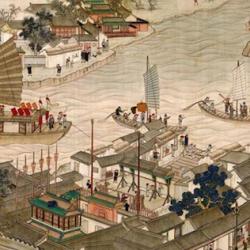Rummaging around John McGuckin’s magisterial, encyclopedic, and very big history of the first millennium of Christianity, The Path of Christianity, uncovers some delightfully unexpected treasures. In chapter 7, he examines the reasons for the focus on Greek and Latin Christianity, and laments that “the non-Greek and non-Latin Christianities of the ancient world . . . have their own stories: much of which has been overlaid and forgotten, and some of it entirely lost, to the universal church” (482). He spends the rest of the chapter summarizing what we know about Christianity in Syria, Arabia, China, India, Armenia, Georgia, Nubia, and Ethiopia.
He speculates that “the gospel probably came to China via the missions of the Syrian church, notably out of the Byzantine-era patriarchate of Antioch.” Evidence is hard to come by, but some remains “literally cut into stone, such as the famous stele of Xian, set up by Nestorian missionaries in the early eighth century to celebrate their missionizing in 635” (489–90).
The Tang dynasty suppressed Christian missions along with Buddhists and Zoroastrians, but they “isolated communities clung on for a long time,” evidenced by Christian gravestones.” What the Tang started, the Jesuits finished: “Finding indigenous Christians with Syriac traditions and dissident views (concerning the papacy and christological matters) already present, the Jesuit missionaries consigned the ‘heretical’ materials to the flames and decided to ‘reevangelize’ them” (491). As a result, we have much less than we might from the era of China’s first missionaries.
McGuckin credits Ethiopian claims to have a connection with Judaism: “The Ethiopians . . . observe both circumcision and baptism; both Shabbat and Sunday; and they also preserve books in their canon that were not only never accepted anywhere else but that more or less fell from existence everywhere else,” including the book of Enoch. Links between Judaism and Ethiopia go back at least to the Ethiopian eunuch, but McGuckin rightly observes that the story in Acts 8 treats the eunuch as already a God-fearer: “The trade routs to the holy city from Ethiopia . . . were well-traveled in antiquity, and there is no reason to doubt a historical connection from the earliest times, a connection that has remained a vital and dominant part of Ethiopian church life ever since” (503).










